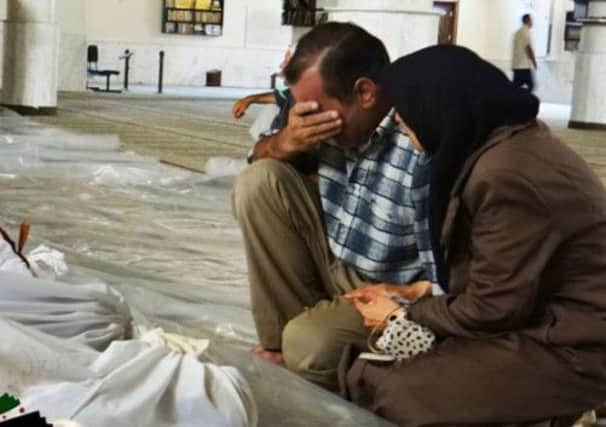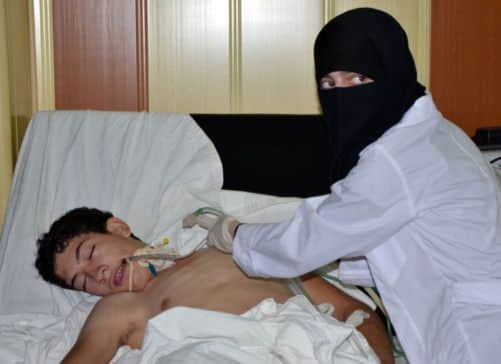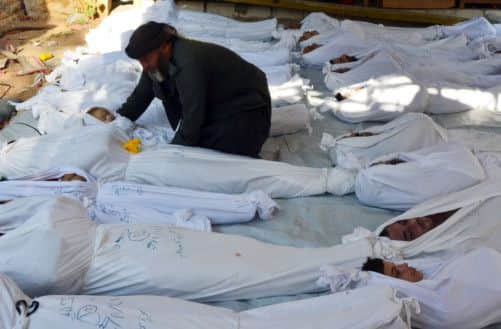Syria: Hundreds killed in apparent gas attack


• UN urged to act after claims that Syrian chemical attack could have killed as many as 1,300 lives
• At least 100 deaths documented as 20-man UN inspection team visit Syria to investigate
Advertisement
Hide AdAdvertisement
Hide Ad• Footage of the aftermath of attacks shows children convulsing and suffering from breathing difficulties in hospital


Anti-government activists claim rockets with toxic gas killed up to 1,360 people when they were launched on the outskirts of Damascus as part of a major bombardment of rebel forces. Harrowing footage appeared to show dozens of bodies, including those of young children with no visible wounds, laid out on the floor of a clinic.
People choking and foaming at the mouth were also shown.
State television confirmed a “series of operations” had been carried out in the area, but the Syrian government dismissed the allegations of chemical attacks as “absolutely baseless”.
Information minister Omran al-Zoubi described the rebels’ claims as “disillusioned and fabricated”.


A spokesman for United Nations Secretary-General Ban Ki-moon said he was “shocked” by the alleged attack and an emergency meeting of the UN security council was called last night.
Britain and France are expected to officially request a UN investigation and Foreign Secretary William Hague warned that, if verified, the attack “would mark a shocking escalation in the use of chemical weapons in Syria”.
If chemical warfare agents were used in the offensive in the suburbs east of the capital, confirmation of the upper end of the reported death toll – which varies from 100 to 1,360 – would make it the deadliest alleged chemical attack in Syria’s bloody two-year civil war, and the worst chemical attack since Saddam Hussein’s assault on Kurdish rebels in Halabja in 1988.
The scale of the alleged attack has raised questions over why President Bashar al-Assad’s regime would use chemical agents while UN investigators are in the country to look into previous alleged chemical attacks.
Advertisement
Hide AdAdvertisement
Hide AdAke Sellstrom, a chemical weapons expert leading a 20-member strong delegation, said he wants to investigate yesterday’s attack. However Syria would need to agree to any request made through the UN by a member state.
Heavy shelling yesterday pounded the capital’s suburbs of Zamalka, Arbeen and Ein Tarma, according to the Syrian Observatory for Human Rights monitoring group.
Rami Abdul-Rahman, director of the UK-based group, said activists in the region said “poisonous gas” was fired in rockets as well as from the air. He said that he has documented at least 100 deaths, but it was not clear whether the victims died from shelling or toxic gas.
Another group, the Local Co-ordination Committee, said 1,360 were killed with hundreds more injured. The Syrian National Coalition, Syria’s main opposition group in exile, put the number at 1,300, a figure based on accounts and photographs by activists on the ground.
George Sabra, head of the coalition, said the attack constituted “a turning point in the regime’s operations”, adding: “This time it was for annihilation rather than terror.”
In dozens of graphic videos circulated in the wake of the offensive, children can be seen foaming at the mouth while one man is filmed having a fit. In another video, shot in a medical unit in the village of Jobar, eyewitnesses claim the chemical attack happened around dawn, with one fraught man – believed to be a medical worker – describing it as a “catastrophe” of “huge proportions”.
He said: “The number of injuries and martyrs among children and civilians was enormous. The number of children was striking. I myself handled 50 dead children. They were all gone, with no signs of life.”
He added that some people made a “big mistake” by retreating to basements, where the “heavy” gas descended, causing the toll of the dead and injured to rise. Some people, he added, even started fires which only made the situation worse.
Advertisement
Hide AdAdvertisement
Hide AdA nurse at Douma Emergency Collection facility, Bayan Baker, said: “Many of the casualties are women and children. They arrived with their pupils constricted, cold limbs and foam in their mouths. The doctors say these are typical symptoms of nerve gas victims.”
Speaking as he left an emergency meeting of EU foreign ministers yesterday, Mr Hague said: “We do not have military forces in Syria, but we can pursue this very strongly at the Security Council. We are talking to others at the Security Council now about what we can do. We have to bear in mind whenever we have tried to pass a strong resolution at the Security Council, we have met vetoes.”
The Syrian government and opposition groups have repeatedly accused each other of chemical warfare, something US President Barack Obama warned was a “clear red line”.
Earlier this year, Prime Minister David Cameron backed Washington’s “candid assessment” that the Assad regime had used chemical weapons.
Assad’s strongest ally Russia also called for an investigation, but condemned the activists’ claims. A foreign ministry spokesman in Moscow claimed the strike was a “provocation” to discredit the government.
Background: Not thought to be first attack
President Bashar al-Assad’s officials have said they would never use poison gas against their own people.
However, the US believes his forces have deployed small amounts of sarin gas in the past, which Washington called a “red line” that justified military aid for the rebels.
US intelligence services are of the view the regime has used sarin and other weapons at least four times in the past year, killing between 100 and 150 people.
Advertisement
Hide AdAdvertisement
Hide AdAssad’s government has accused the rebels of using chemical weapons, which they deny. Both sides clashed over an alleged chemical strike in March in Khan al-Assal, near Aleppo, that killed dozens of people.
The recently arrived UN team intends to ascertain whether chemicals were used by collecting samples, carrying out interviews, and examining witnesses.
Gwyn Winfield: ‘Horrific evidence consistent with chemical attack’
• Gwyn Winfield is editorial director of CBRNe World. He is a leading authority on chemical, biological, radiological and nuclear defence issues.
THE attack appears to fall into one of three categories; it is either pure sarin, a riot-control agent, or an adulterated chemical warfare agent.
When you look at the clothes people were wearing when they were receiving the bodies, it’s clearly not a super toxic, because the amount of agent would have had serious effects on those helping them, with a lot of secondary casualties.
That suggests it’s not a pure military grade chemical warfare agent. We might well see that it’s a high concentration of a riot-control agent. There’s also been a number of suggestions that it’s some kind of cocktail of various agents that has been used.
It certainly seems that in terms of the spread of agent, it’s been delivered by a military. Whether that’s the Free Syrian Army (FSA), a false flag attack, or Bashar al-Assad, we probably will not ever know, or certainly will not know for years to come.
Advertisement
Hide AdAdvertisement
Hide AdIn terms of the amount that has been put down, even to get the lower levels of casualties that are being quoted, it’s come out of an artillery barrage, whether a howitzer, mortar, or rocket. It’s a large amount of agent.
If you get hit by a large amount of riot-control agent, the amount of respiratory distress is very close to the amount of respiratory distress you would suffer from an organophosphate. Pinpoint pupils, runny noses, and excess salivation are all symptoms where you are likely to be have been hit with some form of organophosphate. In the footage we have seen, some people do not necessarily seem to be like that.
They seem to be quite sallow, and some seem to be having convulsions. But they have just been in a traumatic experience and are shocked, so it’s difficult to look at any of those signs and symptoms and say definitively that it’s any one form of agent.
The United Nations inspectors will need to be able to get into the theatre as soon as possible. Confirmation will be as sketchy for them as it is for us, but certainly, they will be required to go there and take soil samples and, more importantly, blood samples. They should then be able to work out whether there is a nerve agent or an organophosphate present.
The reported number of casualties is easily consistent with chemical warfare agents, which work well in urban environments.
I find the timing of the attack suspicious to say the least. If the whole thing is Assad deciding to give the UN inspectors a chance to see first hand what a chemical warfare agent can do, I would be very surprised. In any crime, you always try to look at who benefits.
There’s no doubt that the strategic winner will be the FSA leadership, who will now benefit from the obvious crossing of the red line that President Barack Obama has talked about.
America ‘does not want plunged into yet another war in the Arab world’
Advertisement
Hide AdAdvertisement
Hide AdTHE United States is opposed to even limited military intervention in Syria because the Obama administration believes it would not be in American interests if rebels seize power, according to the chairman of the Joint Chiefs of Staff.
In a letter to a congressman, General Martin Dempsey said the military is clearly capable of taking out Syrian president Bashar al-Assad’s air force and shifting the balance of the country’s two-year war back towards the armed opposition.
But he said the approach would plunge the US into another war in the Arab world and offer no strategy for peace in a nation plagued by ethnic rivalries.
The general effectively ruled out cruise missile attacks and other options that would not require US troops on the ground.
“Syria today is not about choosing between two sides, but rather about choosing one among many sides,” Gen Dempsey said in the letter dated 19 August to Republican Eliot Engel. “It is my belief that the side we choose must be ready to promote their interests and ours when the balance shifts in their favour. Today, they are not.”
Gen Dempsey’s assessment will hardly please members of the fractured Syrian opposition leadership and some members of the Obama administration who have wanted greater support to help the rebellion end Assad’s four-decade family dynasty.
Gen Dempsey said Syria’s war was “tragic and complex”.
“It is a deeply rooted, long-term conflict among multiple factions, and violent struggles for power will continue after Assad’s rule ends,” he wrote. “We should evaluate the effectiveness of limited military options in this context.”
Mr Engel responded to the letter with disappointment yesterday.
Advertisement
Hide AdAdvertisement
Hide Ad“Until we are prepared to severely diminish the regime’s ability to inflict harm upon its own citizens and even the playing field – such a moderate opposition stands little chance against the regime’s scuds, tanks and planes,” he said.
Despite calling for Assad to leave power in 2011, President Barack Obama has refused to allow the US to be drawn directly into the conflict.
Officials have said, however, that the US is prepared to provide lethal aid to moderate units among the opposition ranks. It is unclear what, if any, weapons have been delivered so far.